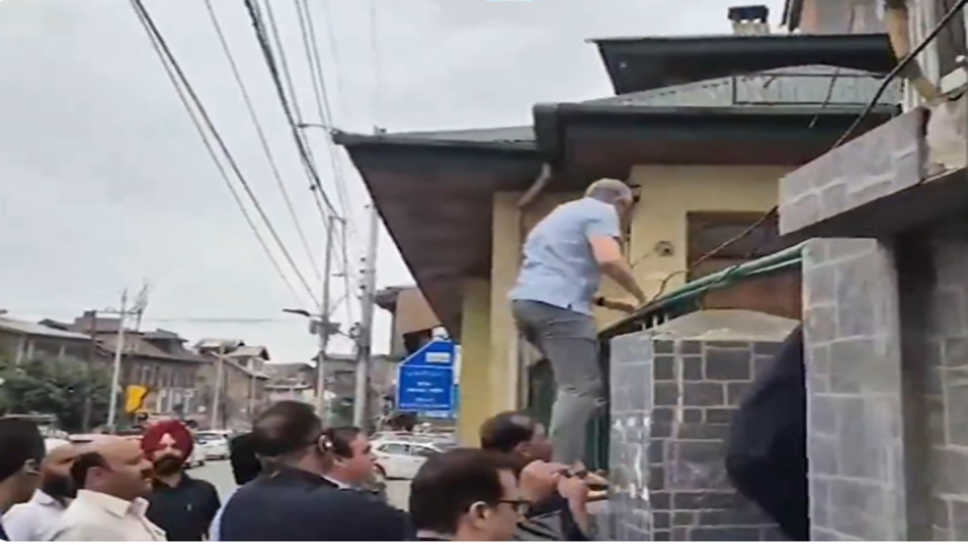Omar Hops Fence to Enter Martyrs’ Graveyard, Slams Police Obstruction

Omar Hops a Fence to Reach Martyrs’ Cemetery: ‘Policemen Sometimes Forget the Law’
In a moment that blended symbolism with defiance, political leader Omar made headlines after hopping over a locked fence to enter the Martyrs’ Cemetery—one of the most emotionally charged spaces in the region. The dramatic act, captured on video and widely shared, quickly sparked debate around civil rights, state authority, and the sanctity of memorial spaces.
Omar, visibly frustrated by the police presence that prevented his entry through the main gate, decided not to wait. Dressed in his usual understated attire, he approached a side of the enclosure, climbed the metal bars, and jumped down into the grounds. Moments later, he was seen offering prayers at several gravesites before speaking briefly to supporters gathered outside.
Later, when asked about the incident, he offered a pointed remark: “Policemen sometimes forget the law. They become instruments of politics, not protectors of rights.”
A Cemetery and a Conflict
The Martyrs’ Cemetery is not just a burial ground. It holds within it the memories of resistance, loss, and contested histories. For many, it is a sacred place, a space where families come to remember those who lost their lives in periods of unrest, military operations, and social upheaval. Over the years, access to the site has become increasingly complicated, particularly during politically sensitive times or on specific anniversaries.
On the day of Omar’s visit, barricades had been placed around the entrance. Police officials stated that "precautionary security measures" were in place due to concerns over “potential gatherings that could turn volatile.” Yet, critics argue that such restrictions are often used to suppress political dissent and prevent public figures from making symbolic visits that might mobilize support or stir public emotion.
Omar, a long-time advocate of civil liberties and political reconciliation, seemed to challenge precisely this form of control. “Visiting a graveyard should not require police clearance,” he said. “I didn’t break the law—I broke through indifference.”
A Statement Without Words
Observers say Omar’s decision to jump the fence—rather than wait for permission or leave in protest—was deliberate and layered. It wasn’t just a physical act of entry; it was a silent indictment of authority. He made no speech upon entry. He didn’t raise slogans. Instead, he walked straight to specific graves, laid flowers, stood in silence, and offered personal prayers.
That visual—of a political figure circumventing official barriers to pay respects—carried a weight of its own. Social media lit up with reactions. Some hailed it as a powerful symbol of resistance. Others criticized it as a publicity stunt. But few were indifferent.
Police Response and Public Reaction
Authorities issued a statement shortly after the incident. “Mr. Omar was advised not to proceed due to ongoing security alerts in the area. His entry into a restricted zone without clearance is being reviewed as a potential breach of security protocol,” the release said.
However, many citizens took to platforms like X (formerly Twitter) and Instagram to defend Omar’s actions. “How dangerous can one man praying at a graveyard be?” wrote one user. Another said, “When access to grief becomes a political act, we must ask who is really breaking the law.”
Even some legal professionals weighed in. A retired judge commented in a televised panel, “There is no law that prohibits peaceful entry into public or religious spaces unless a curfew or formal ban is in place. Symbolic actions like these fall under freedom of movement and expression.”
More Than a Fence
For many, the fence Omar climbed is representative of the broader barriers that communities face—barriers to justice, to expression, to memory. His act wasn’t just about one cemetery or one day. It tapped into a deeper sentiment felt by those who have seen history erased, re-written, or locked away under layers of security justifications.
Family members of the buried martyrs later expressed their support for the act. “We thank him for showing the courage to stand with our pain. They may try to erase names, but someone has to keep the memory alive,” said an elderly woman whose son lies buried in the cemetery.
Political Implications
The move also signals Omar’s reassertion into the public and political consciousness. In recent years, his visibility had waned, especially following crackdowns, detentions, and the stifling of regional autonomy. But this fence-hop may have reignited his connection with the grassroots—those who see civil liberties as non-negotiable and symbols of mourning as fundamental to identity.
Some political commentators suggest the act was calculated—not in a manipulative sense, but as a well-timed message. “Omar has always walked a fine line between diplomacy and defiance. This act places him firmly back in the resistance narrative,” said a columnist for a leading national daily.
His opponents, however, called it reckless. “Lawmakers should not behave like lawbreakers,” one rival party leader said. “If everyone jumps fences to prove a point, where will order go?”
Omar, meanwhile, appeared unfazed. In a brief interview, he said, “If they had opened the gate, I would have walked through. Since they locked it, I climbed. That’s all. Let’s not pretend respect for the dead is a crime.”
The Larger Debate
The incident has rekindled the debate around the politicization of public spaces. Whether it’s a rally, a protest, a grave visit, or a cultural event—many activists argue that increased surveillance and restrictions are shrinking the democratic space.
“Today it’s a cemetery. Tomorrow, it could be a classroom, a library, or a shrine,” warned one civil rights lawyer. “We are normalizing a society where fear governs access to public memory.”
At the heart of the issue is not just Omar’s act, but what it represents: the growing tension between the state’s need for control and the citizen’s right to expression. And perhaps more importantly, the right to grieve, remember, and resist—without permission.
Omar’s climb over the fence may go down as one of those small moments that spark larger conversations. Whether seen as defiance or devotion, it serves as a reminder that memory—and the right to honor it—should never be gated, guarded, or politicized.
As the sun set over the Martyrs’ Cemetery that day, the silence inside was punctuated not by slogans or speeches, but by one man’s choice to keep walking, even when the gate was shut.
